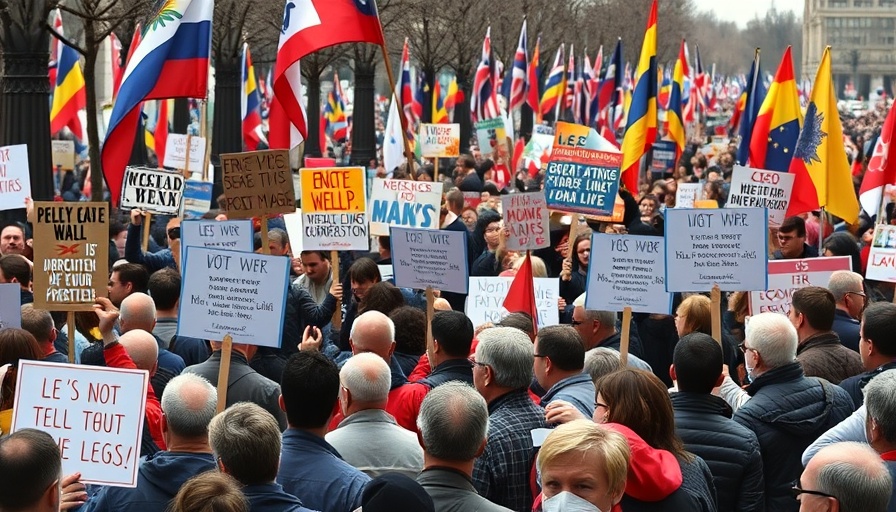
United Voices Against Political Giants: The "Hands Off!" Movement
This past Saturday, over 1,200 "Hands Off!" demonstrations erupted across the United States, galvanizing more than 150 groups. These groups included civil rights organizations, labor unions, LGBTQ+ advocates, veterans, and election activists, all gathering together in a powerful display of dissent against the actions of President Donald Trump and billionaire Elon Musk. The protests spoke to a variety of socio-economic issues, highlighting the overarching narrative of perceived governmental neglect, economic insecurity, and shrinking civil liberties.
The Core Concerns of the Protest
Protesters rallied at iconic locations such as the National Mall in Washington, D.C., state capitols, and numerous sites in all 50 states. Their collective voice was loud and clear as they condemned the Trump administration for policies that are seen as detrimental to a wide range of citizens. Specific grievances included the mass firing of federal workers, the closure of Social Security Administration field offices, the deportation of immigrants, and the trimming of protections for transgender individuals. These actions have stirred anger and fear among citizens who rely on these federal programs for support.
Musk's Role in Government Efficiency
Elon Musk's involvement in this political landscape has become a focal point of contention. As the head of the newly formed Department of Government Efficiency, Musk claims to be saving taxpayers billions. Critics, however, argue that his approach prioritizes profit over people, threatening the livelihoods of hardworking federal employees and undermining social welfare systems.
Paul Osadebe, a lawyer from the U.S. Department of Housing and Urban Development and a labor union steward, articulated the frustrations of many at the Washington protest. He expressed that billionaires and oligarchs, like Trump and Musk, place too high a value on profits and power while disregarding the foundational role of federal workers in establishing economic security for families and communities. His words resonated with the crowd, illuminating the divide between the socio-economic elite and the average citizen.
Across the Nation: Local Reactions
The sentiment at these rallies was not isolated. In Massachusetts, protestors on Boston Common brandished signs demanding, "Hands off our democracy" and "Hands off our Social Security!" Meanwhile, in Ohio, turnout at the Statehouse in Columbus, despite dreary weather, reflected the persistent discontent among citizens. Roger Broom, a retired Republican, voiced his disapproval of Trump's governance, stating that the president is "tearing this country apart" and leading an "administration of grievances."
Historical Context and Background
To fully understand the implications of these protests, it's vital to look at the historical context in which they occur. The rise of populism in American politics has created significant divides, often pitting the interests of wealthier elites against those of everyday citizens. Previous administrations have faced protests from various groups, but what separates the current unrest is its diverse coalition and focus on a variety of intersecting issues: economic stability, social justice, and government accountability.
Social Connection: Why These Protests Matter
The "Hands Off!" demonstrations are more than just expressions of dissent; they signify a yearning for community, shared ideals, and mutual support among those feeling marginalized. In a time where political discourse often relegates the voices of everyday individuals, these protests promote solidarity across different demographics and ideologies.
Inspirational Quotes and Anecdotes
Statements from participants at the rallies capture the essence of what these protests represent. The chorus of voices demanding action underscores a shared belief in the importance of protecting democracy and advocating for social justice. The movement serves as a reminder that change is only possible when citizens band together, echoing the sentiment that, without action, complacency prevails.
The Future: Insights and Predictions
As we look ahead, it's clear that the "Hands Off!" movement has laid the groundwork for further political engagement. As more citizens mobilize for socio-economic justice, other groups may find inspiration in the protests, giving rise to additional initiatives advocating for accountability at all levels of government. The 2025 political landscape could witness a surge in grassroots activism, driven by the very citizens feeling the effects of policies enacted by the elite.
Final Thoughts and Encouragement to Engage
Whether you're a supporter of the movement or simply a concerned citizen viewing the events unfold, it's vital to understand the implications these rallies may have. Participation in civic discourse—whether through protests, discussions, or voting—can drive meaningful change within your community. Understanding these dynamics can empower you to take a stand for the issues you care about—and inspire others to do the same.
 Add Row
Add Row  Add
Add 




Write A Comment